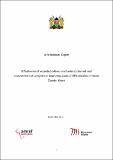Preliminary report - Effectiveness of expanded delivery mechanisms channels and empowerment of caregivers in improving access of ORS and Zinc in Narok County, Kenya
View/
Publication Date
2015-09Type
Otherviews
downloads
Metadata
Show full item record
Abstract/
Millennium development goal 4 calling for a reduction of child deaths by two thirds by 2015 up from the 1990 levels is unlikely to be achieved in Africa. Pneumonia, diarrhoea and malaria account for more than 50% of deaths of children under five years of age. Africa and Asia account for nearly 90% of child deaths due to pneumonia and diarrhoea, and diarrhoea alone causes about 11% of all child deaths (UNICEF, 2012). In communities with poor hygiene and sanitation practices, young children may suffer over 6 to 10 episodes of diarrhoea per year. In Kenya diarrhoea contributes to over 20% of under five year old child mortality and severe childhood diarrhoea (MOPHS, 2010). This is in spite of childhood diarrhoea being highly amenable to prevention and early management through breastfeeding, good hygiene practices and use of low osmolarity Oral Rehydration Salts (ORS solution) and Zinc supplementation to avoid severe illness and death. A cluster randomized study in Bangladesh reported that children having Zinc supplementation had a shorter duration and lower incidence of diarrhoea than children in the comparison group (Baqui et al, 2010). Access to correct information on home management of childhood diarrhoea and to ORS and Zinc at community level remains one of the bottlenecks to effective implementation of this life saving commodities. This problem has its highest impact in hard to reach communities.
Publisher
Ministry of Health, KenyaCollections
- General - GEN [367]

